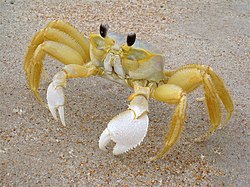| Ocypodidae | |
|---|---|
 | |
| Leptuca pugilator , Florida | |
 | |
| Ocypode quadrata , Florida | |
| Scientific classification | |
| Domain: | Eukaryota |
| Kingdom: | Animalia |
| Phylum: | Arthropoda |
| Class: | Malacostraca |
| Order: | Decapoda |
| Suborder: | Pleocyemata |
| Infraorder: | Brachyura |
| Superfamily: | Ocypodoidea |
| Family: | Ocypodidae Rafinesque, 1815 |
| Subfamilies | |
| |
The Ocypodidae is a family of semiterrestrial crabs that includes ghost crabs and fiddler crabs. These crabs are found along tropical and temperate shorelines worldwide.
Contents
Some genera previously classified within the Ocypodidae family have been reclassified into separate families within the superfamily Ocypoidea, such as Dotillidae and Macrophthalmidae. In 2016, the genus Uca was divided into 13 genera through the elevation of its subgenera to genus status, among other taxonomic changes. [1] Further refinements have been made to the family's organization, resulting in 4 subfamilies, approximately 13 extant genera, and around 180 described species as of 2020. [2] [3] [4]
The majority of the Ocypodidae species are fiddler crabs, the exceptions being the members of the genus Ocypode , ghost crabs, and the genus Ucides , mangrove crabs. [2] [3]